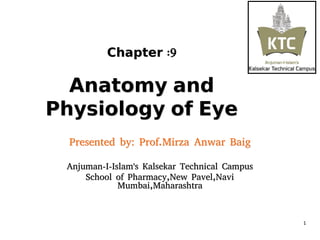
Eye Anatomy and Physiology Chapter
- 1. ChapterChapter :9:9 AnatomyAnatomy andand PhysiologyPhysiology ofof EyeEye Presented by: Prof.Mirza Anwar BaigPresented by: Prof.Mirza Anwar Baig Anjuman-I-Islam's Kalsekar Technical CampusAnjuman-I-Islam's Kalsekar Technical Campus School of Pharmacy,New Pavel,NaviSchool of Pharmacy,New Pavel,Navi Mumbai,MaharashtraMumbai,Maharashtra 11
- 2. Overview • The eye is supplied by the optic nerve (2nd cranial nerve). • It is almost spherical in shape and is about 2.5 cm in • diameter. • It is possible to see with only one eye but three- dimensional vision is impaired when only one eye is used, especially in relation to the judgement of distance.
- 3. Acessory structures of eye:
- 4. Acessory organs of eye:
- 5. Secretion of lacrimal fluid:
- 6. Functions • The fluid that fills the conjunctival sac consists of tears and the oily secretion of tarsal glands and is spread over the cornea by blinking. • The functions of this mixture of fluids include: 1. Washing away irritating materials, e.g. dust, grit 2. The bacteriocidal enzyme lysozyme prevents microbial infection 3. Oiliness delays evaporation and prevents drying of the conjunctiva 4. Nourishment of the cornea.
- 8. Anatomical features: 1. Sclera • The sclera, or white of the eye. • It consists of a firm fibrous membrane that maintains the shape of the eye and gives attachment to the extraocular or extrinsic muscles of the eye. 2. Cornea • Light rays pass through the cornea to reach the retina. • The cornea is convex anteriorly. • Involved in refracting or bending light rays to focus them on the retina. 3. Choroid • The choroid lines the posterior five-sixths of the inner surface of the sclera. • Very rich in blood vessels and is deep chocolate brown in colour. • Light enters the eye through the pupil, stimulates the nerve endings in the retina and is then absorbed by the choroid.
- 9. 4. Ciliary body • Consisting of ciliary muscle (smooth muscle fibres) and secretory epithelial cells. • Contraction and relaxation of the ciliary muscle changes the thickness of the lens which bends, or refracts light rays entering the eye to focus them on the retina. • The epithelial cells secrete aqueous fluid into the anterior segment of the eye, i.e. the space between the lens and the cornea (anterior and posterior chambers). • The ciliary body is supplied by parasympathetic branches of the oculomotor nerve (3rd cranial nerve). • Stimulation causes contraction of the smooth muscle and accommodation of the eye. 5. Iris: • visible coloured part of the eye. • It is a circular body composed of pigment cells and two layers of smooth muscle fibres, one circular and the other radiating. In the centre there is an aperture called the pupil. • The iris is supplied by parasympathetic and sympathetic nerves. Parasympathetic stimulation constricts the pupil and sympathetic stimulation dilates it
- 10. Contraction and relaxation of circular and radial muscles:
- 11. Retina: 1. Innermost layer,extremely delicate structure and is especially adapted for stimulation by light rays. 2. It is composed of several layers of nerve cell bodies and their axons, lying on a pigmented layer of epithelial cells which attach it to the choroid. 3. The layer highly sensitive to light is the layer of sensory receptor cells: rods and cones. 4. Near the centre of the posterior part is the macula lutea, or yellow spot. 5. In the centre of the area there is a little depression called the fovea centralis, consisting of only cone-shaped cells. 6. Towards the anterior part of the retina there are fewer cone- than rod-shaped cells. 7. The rods and cones contain photosensitive pigments that convert light rays into nerve impulses. 8. The small area of retina where the optic nerve leaves the eye is the optic disc or blind spot. It has no light-sensitive cells.
- 12. Interior of the eye: 1. The anterior segment of the eye, i.e. the space between the cornea and the lens, is incompletely divided into anterior and posterior chambers by the iris . 2. Both chambers contain a clear aqueous fluid (humour) secreted into the posterior chamber by ciliary glands. 3. It circulates in front of the lens, through the pupil into the anterior chamber and returns to the venous circulation through the scleral venous sinus (canal of Schlemm) in the angle between the iris and cornea. 4. There is continuous production and drainage but the intraocular pressure remains fairly constant between 1.3 and 2.6 kPa (10 to 20 mmHg). 5. An increase in this pressure causes glaucoma. Aqueous fluid supplies nutrients and removes waste from the transparent structures in the front of the eye that have no blood supply, i.e. the cornea, lens and lens capsule.
- 16. The cyclical bleaching and regeneration of photopigment
- 17. Light and dark adaptation
